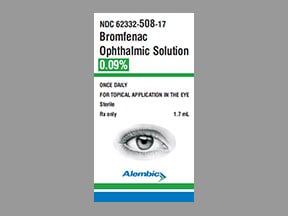
Bromfenac Sodium (once-daily) Coupons & Savings Card – Discount Prices from $33.16
My prescription
Edit
1.7ML of 0.09%, Bromfenac Sodium (once-daily) (1 Bottle)
Select pharmacy

CVS
$33.16
COUPON PRICE
Walgreens
$44.10
COUPON PRICE
Albertsons
$60.61
COUPON PRICE
Walmart
$62.87
COUPON PRICEBromfenac Sodium (once-daily) savings card
Show this card to your pharmacist
CVS
$33.16
BIN
ID
PCN
GRP
019876
LH856FF322
CHIPPO
LHX
Powered by
Bromfenac Sodium (once-daily) dosage forms
Dosage Quantity Price from Per unit 1.7ML of 0.09% 1 Bottle $33.16 $33.16 1.7ML of 0.09% 2 Bottles $48.03 $24.02 1.7ML of 0.09% 3 Bottles $70.89 $23.63
| Dosage | Quantity | Price from | Per unit |
|---|---|---|---|
| 1.7ML of 0.09% | 1 Bottle | $33.16 | $33.16 |
| 1.7ML of 0.09% | 2 Bottles | $48.03 | $24.02 |
| 1.7ML of 0.09% | 3 Bottles | $70.89 | $23.63 |
Bromfenac Sodium (once-daily) Warnings
When using bromfenac sodium ophthalmic solution once daily, it's important to be aware of certain risks:
Allergic Reactions: This medication contains sodium sulfite, which can cause allergic reactions, including severe asthma attacks, in some individuals. People with asthma may be more susceptible to these reactions.
Delayed Healing: Bromfenac, like other nonsteroidal anti-inflammatory drugs (NSAIDs), may slow or delay the healing process. Using it alongside topical steroids can further increase this risk.
Cross-Sensitivity: If you've had allergic reactions to aspirin, other NSAIDs, or similar drugs, you might also react to bromfenac. Use caution if you have such a history.
Increased Bleeding Risk: NSAIDs can interfere with blood clotting, potentially leading to increased bleeding in the eye, especially during or after surgery. If you have bleeding disorders or are on medications that prolong bleeding, consult your doctor before using bromfenac.
Corneal Issues: In some cases, use of bromfenac has been associated with serious corneal problems, such as thinning, erosion, or perforation, which can threaten vision. Patients with conditions like diabetes, rheumatoid arthritis, or those undergoing repeated eye surgeries may be at higher risk. If you experience any signs of corneal issues, stop using the medication and seek medical attention immediately.
Contact Lens Use: Do not use bromfenac while wearing contact lenses. The preservative in the solution can be absorbed by soft lenses. Remove your lenses before application and wait at least 10 minutes before reinserting them.
Always follow your healthcare provider's instructions and report any unusual symptoms promptly.
Bromfenac Sodium (once-daily) Side Effects
Bromfenac sodium, a nonsteroidal anti-inflammatory drug (NSAID) used as an eye drop, is commonly prescribed to reduce pain and inflammation following cataract surgery. While many individuals tolerate this medication well, some may experience side effects. Common side effects include:
- Eye irritation: This may present as burning, stinging, itching, or redness in the eyes.
- Eye discomfort or pain: Some individuals might feel mild to moderate discomfort or pain in the eye.
- Blurred vision: Temporary blurring of vision can occur after application.
- Sensation of a foreign body in the eye: A feeling that something is in the eye may be experienced.
- Increased tearing: Excessive tearing or watery eyes can occur.
- Dryness of the eye: Some may experience a sensation of dry eyes.
- Ocular hyperemia: This refers to redness or dilation of blood vessels in the eye.These side effects are typically mild and temporary. However, if they persist or worsen, it's important to consult with a healthcare professional.
Serious side effects are rare but require immediate medical attention. These include:
- Severe eye pain or swelling: Intense discomfort or noticeable swelling in the eye.
- Worsening vision: Significant changes or deterioration in vision.
- Increased sensitivity to light: Heightened discomfort when exposed to light.
- Signs of an allergic reaction: Symptoms such as rash, itching, swelling (especially of the face, tongue, or throat), severe dizziness, or difficulty breathing.If any of these serious side effects occur, discontinue use and seek medical attention immediately.It's essential to follow your doctor's instructions when using bromfenac sodium eye drops and to report any unusual symptoms promptly.
Bromfenac Sodium (once-daily) Interactions
When using bromfenac sodium once daily, it's important to be aware of potential interactions with other substances:
Alcohol and Tobacco: Consuming alcohol or using tobacco products while on bromfenac can increase the risk of stomach bleeding. It's advisable to avoid these substances during treatment.
High-Fat Foods: Taking bromfenac with high-fat meals can significantly reduce its absorption, making the medication less effective. To ensure optimal absorption, take bromfenac on an empty stomach, either one hour before or two hours after eating.
Other Medications: If you're using other eye medications, wait at least five minutes between applying each one to prevent interactions. Additionally, inform your healthcare provider about all medications you're taking, including blood thinners like Warfarin or steroid eye drops, as these can interact with bromfenac.
Herbal Supplements: Certain herbal supplements, such as cumin, may increase the risk of bleeding when taken with bromfenac. It's important to discuss any herbal supplements you're using with your healthcare provider.
Always consult your healthcare provider before starting or stopping any medication or supplement to ensure safe and effective use of bromfenac sodium.
